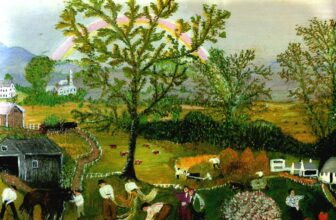
The Story of Abaporu Painting
In the heart of modern art history, few paintings carry as much cultural weight and symbolic richness as Abaporu. A mysterious figure, a cactus, and a sun, on a seemingly simple canvas, sparked an artistic revolution in Brazil, giving rise to a unique cultural movement and changing the way Brazilians viewed their own identity. But who painted Abaporu? Why is it called that? And what does it truly mean?
To understand Abaporu, one must journey back to the early 20th century in Brazil, a country in search of its soul, its voice, and its visual identity.
Who Painted Abaporu?
The woman behind Abaporu was Tarsila do Amaral, a trailblazing Brazilian painter who emerged as a central figure in Latin America’s modernist movement. Born in 1886 in Capivari, São Paulo, Tarsila grew up on a coffee plantation, surrounded by the natural beauty of the Brazilian landscape, a theme that would later permeate her work. She came from a wealthy family, which allowed her to study art in São Paulo and eventually in Paris, where she trained under the likes of André Lhote, Fernand Léger, and other leading artists of the European avant-garde.
But while her early artistic influences were European, Tarsila’s heart was always drawn back to Brazil. Her mission became clear: to create an art form that was distinctly Brazilian, not just a copy of European styles. She once said, “I want to be the painter of my country.” And with Abaporu, she fulfilled that desire in the most revolutionary way.
Abaporu was painted in 1928 as a birthday gift for her husband at the time, the writer and poet Oswald de Andrade, one of the key figures in Brazil’s modernist literary movement. Little did they know, this personal gift would become a national treasure.
What Is the Meaning Behind Abaporu?
At first glance, Abaporu is a simple painting. It depicts a human figure with an enormous foot and hand, a tiny head, sitting beside a cactus under a blazing sun. But the simplicity is deceptive. Every element in the painting carries symbolic weight.
The painting’s title, Abaporu, comes from the Tupi-Guarani language, one of the indigenous tongues of Brazil. It means “the man who eats people”, a direct reference to cannibalism. But this isn’t literal cannibalism. It’s cultural cannibalism, an idea that would become central to Brazil’s identity through the Anthropophagic Movement (Movimento Antropofágico), which Oswald de Andrade launched shortly after receiving the painting.
The Anthropophagic Movement proposed that Brazil should “devour” European culture, not to mimic it, but to digest and transform it into something entirely Brazilian. Tarsila’s painting, with its primal, organic shapes and mysterious energy, became the visual manifesto of this movement.
The figure in Abaporu, with its disproportionate body, has been interpreted in many ways. The giant foot and hand may represent connection to the land, labor, and physical strength, while the tiny head suggests the domination of physicality over intellect, a reversal of Western values, which traditionally exalt the mind. The cactus, native to Brazil’s arid regions, could symbolize resilience, roots, and national identity.
There’s also a surrealist influence in the painting, seen in its dreamlike proportions and the mystical simplicity of its elements. Yet, it’s more than just surrealism, it’s a new Brazilian aesthetic that reclaims indigenous symbolism and reimagines the country’s artistic future.
Why Is It Called Abaporu?
The name Abaporu was not chosen lightly. Oswald de Andrade, fluent in both literature and symbolism, was immediately struck by the potential of the painting’s imagery. Upon receiving the painting, he was inspired to write the “Manifesto Antropofágico” (Cannibalist Manifesto), which he published in 1928. The title Abaporu, meaning “man who eats people”, was not just provocative. It was a statement.
Oswald believed that Brazilian culture had for too long been colonized by European ideals, aesthetics, and moral standards. Through the lens of cultural cannibalism, he proposed that Brazilians should metaphorically “eat” foreign influences, digesting them, breaking them down, and turning them into something entirely new and uniquely Brazilian.
In this context, Abaporu is the totemic figure of a new artistic consciousness. It’s not just a painting, it’s a philosophy.
The name honors Brazil’s indigenous roots, its pre-colonial cultures, and the power of transformation. The word “abaporu” reminds viewers that identity is not given, it’s made. And in the case of Brazil, it would be made by absorbing, reinterpreting, and reshaping everything that entered its cultural space.
Where Is the Abaporu Painting Now?
Although Abaporu is intrinsically tied to Brazilian culture, it does not currently reside in Brazil. The painting’s journey has been a long and winding one.
For decades after it was painted, Abaporu remained in the possession of private collectors. In the 1990s, it was acquired by Argentine collector Eduardo Costantini, the founder of the Museo de Arte Latinoamericano de Buenos Aires (MALBA). In 1995, he paid over US$1.4 million for it at a Sotheby’s auction, at the time, the highest price ever paid for a Latin American artwork.
Today, Abaporu is housed at the MALBA museum in Buenos Aires, Argentina, where it remains one of the centerpiece attractions. Though it’s not physically in Brazil, Abaporu is deeply cherished by Brazilians and is considered a national icon. It has been featured in exhibitions around the world, from the Museum of Modern Art in New York to retrospectives in São Paulo and Paris.
There have been ongoing discussions and dreams among Brazilian art lovers and institutions about bringing Abaporu back to Brazil permanently. But for now, it remains a cultural ambassador, representing Brazil abroad.
The Legacy of Abaporu
The impact of Abaporu cannot be overstated. It ignited a cultural revolution. It visually encapsulated the goals of the Modern Art Week of 1922, a pivotal event in Brazilian cultural history where artists, writers, and musicians sought to break free from European influence and forge a new national identity.
Tarsila do Amaral, through Abaporu, became the mother of modern Brazilian art. She inspired generations of artists, from her contemporaries to contemporary Brazilian creatives who continue to explore themes of identity, land, body, and resistance.
The Anthropophagic Movement also influenced writers like Haroldo de Campos and Caetano Veloso, musicians from the Tropicália movement in the 1960s, and thinkers who saw cultural cannibalism as a way to understand post-colonial identity. It has even been referenced in architecture, fashion, and political thought.
Abaporu’s unique imagery has become part of Brazil’s cultural DNA. Its forms appear in murals, graffiti, clothing, educational books, and street art. The painting has been reimagined, meme-ified, and idolized. For Brazilians, it’s more than just art, it’s a mirror.
A Painting That Ate the World
What began as a birthday gift between two lovers became one of the most important cultural statements in Latin American history. Abaporu is the fusion of the personal and the political, the indigenous and the modern, the surreal and the real.
Tarsila do Amaral, with her bold strokes and symbolic vision, created a painting that defied boundaries. It didn’t just reflect Brazilian identity, it helped create it.
And though the painting now hangs in Buenos Aires, it belongs to Brazil, in spirit, in soul, and in history. Abaporu continues to speak to new generations, reminding them of the power of art to challenge, transform, and redefine who we are.
In its silent, surreal stillness, Abaporu devours expectations and digests them into something radically, beautifully Brazilian.




